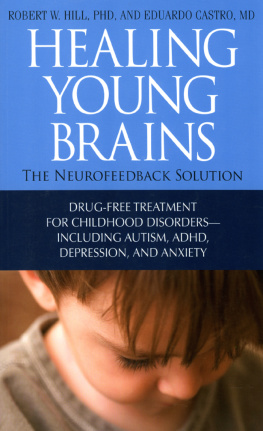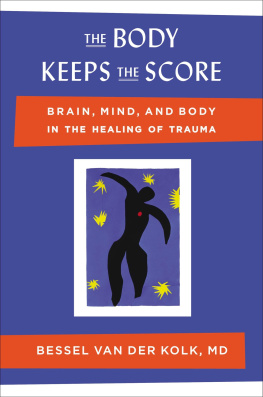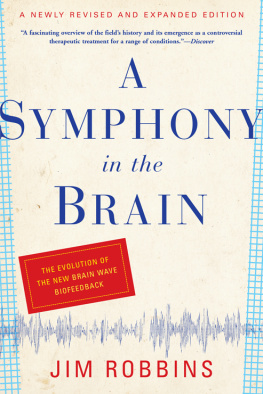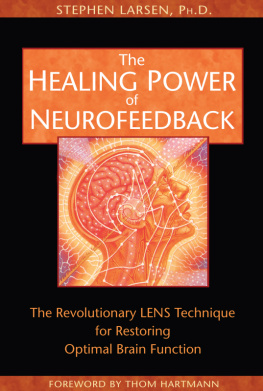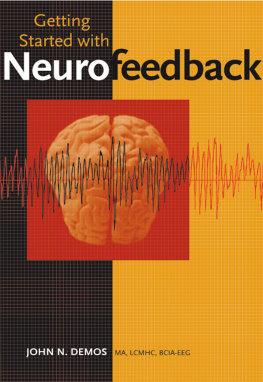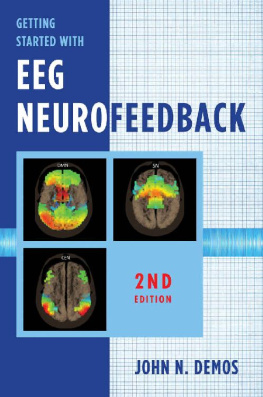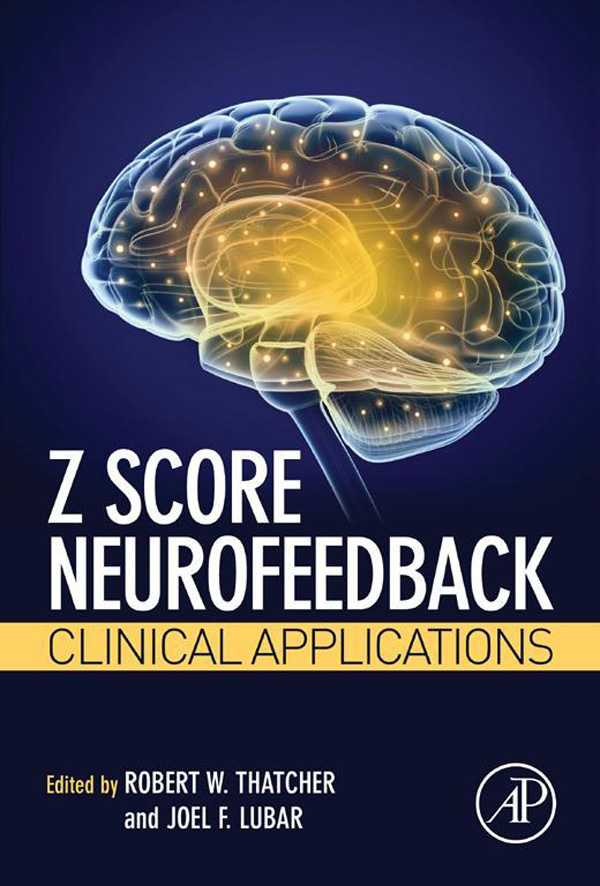Table of Contents
List of tables
- Tables in Chapter 1
- Tables in Chapter 4
- Tables in Chapter 6
- Tables in Chapter 10
- Tables in Chapter 11
- Tables in Chapter 12
- Tables in Chapter 14
List of illustrations
- Figures in Chapter 1
- Figures in Chapter 2
- Figures in Chapter 3
- Figures in Chapter 4
- Figures in Chapter 5
- Figures in Chapter 6
- Figures in Chapter 7
- Figures in Chapter 8
- Figures in Chapter 9
- Figures in Chapter 10
- Figures in Chapter 11
- Figures in Chapter 12
- Figures in Chapter 13
- Figures in Chapter 14
- Figures in Chapter 15
Landmarks
Table of Contents
Z Score Neurofeedback
Clinical Applications
Edited by
Robert W. Thatcher
Joel F. Lubar

Copyright
Academic Press is an imprint of Elsevier
32 Jamestown Road, London NW1 7BY, UK
225 Wyman Street, Waltham, MA 02451, USA
525 B Street, Suite 1800, San Diego, CA 92101-4495, USA
The Boulevard, Langford Lane, Kidlington, Oxford OX5 1GB, UK
Copyright 2015 Elsevier Inc. All rights reserved
No part of this publication may be reproduced or transmitted in any form or by any means, electronic or mechanical, including photocopying, recording, or any information storage and retrieval system, without permission in writing from the publisher. Details on how to seek permission, further information about the Publishers permissions policies and our arrangements with organizations such as the Copyright Clearance Center and the Copyright Licensing Agency, can be found at our website: www.elsevier.com/permissions.
This book and the individual contributions contained in it are protected under copyright by the Publisher (other than as may be noted herein).
Notices
Knowledge and best practice in this field are constantly changing. As new research and experience broaden our understanding, changes in research methods, professional practices, or medical treatment may become necessary.
Practitioners and researchers must always rely on their own experience and knowledge in evaluating and using any information, methods, compounds, or experiments described herein. In using such information or methods they should be mindful of their own safety and the safety of others, including parties for whom they have a professional responsibility.
To the fullest extent of the law, neither the Publisher nor the authors, contributors, or editors, assume any liability for any injury and/or damage to persons or property as a matter of products liability, negligence or otherwise, or from any use or operation of any methods, products, instructions, or ideas contained in the material herein.
ISBN: 978-0-12-801291-8
British Library Cataloguing-in-Publication Data
A catalogue record for this book is available from the British Library
Library of Congress Cataloging-in-Publication Data
A catalog record for this book is available from the Library of Congress
For information on all Academic Press publications visit our website at http://store.elsevier.com/
Typeset by MPS Limited, Chennai, India www.adi-mps.com
Printed and bound in United States of America

Preface
Robert W. Thatcher and Joel F. Lubar
EEG biofeedback also called neurofeedback has a 60-year history in the scientific literature. However, a problem with human neurofeedback methods was inefficiency because improved clinical outcome and changes in the EEG occurred only after many sessions, e.g., 4080 sessions. A large number of sessions are expensive with reduced patient compliance and the need for good clinical outcome in fewer sessions is a pressing need. The first indication that more efficient biofeedback is related to increased specificity of the physiological event was proven in the 1960s when scientists operant conditioned single neurons, groups of neurons, and evoked potentials in only a few sessions. The lack of specificity in human neurofeedback studies was evident by the use of one or two scalp electrodes arbitrarily placed on the scalp in which each electrode was influenced by widespread electrical sources inside the brain and therefore was nonspecific as to the Brodmann areas and networks inside the brain. Also, researchers and clinicians had no standards by which to select thresholds to determine if a feedback signal was to be delivered or not. For example, clinicians would argue for different protocols in which the threshold for alpha rhythms may be 20 V for one clinician or 15 or 25 V for others, etc. Arbitrary thresholds to inhibit rhythms like theta (48 Hz) also occurred, e.g., is the threshold 5 or 10 or 15 V, etc. Still worse was that different clinicians would use different metrics. Some would use relative power, which is a percentage, others would use absolute amplitude in microvolts, others would use ratios of power, others would use ratios of relative power, and others would use arbitrary measures of coherence at different scalp locations and different ages.
In the late 1990s, it became obvious that the lack of specificity and uniform standards resulted in inefficient clinical applications of neurofeedback. As a consequence, the idea of using real-time Z scores to simplify and standardize neurofeedback was suggested by Robert Thatcher in the 1990s and implemented in 2006 with almost an immediate improvement in the efficiency of neurofeedback. That is, good clinical outcome was noticed in <20 sessions and often in <10 sessions soon after the first application of Z-score EEG biofeedback. The reason for the improved clinical efficacy was that different and multiple metrics were reduced to a single common metric, i.e., the metric of a Z score that ranges from 2 or 3 standard deviations no matter what the original metric may be. Further, the Z score removes arbitrary guessing about thresholds because the goal is to reinforce any given EEG measure in the direction of Z=0 which is the center of a reference healthy age-matched normal population that has no psychological problems nor a history of clinical disorders. Reinforcing toward Z=0 is also reinforcing toward greater stability and efficiency in networks of the brain. Dr. Joel Lubar was one of the first to embrace and adopt the Z-score EEG neurofeedback method and immediately reported improved clinical outcome in fewer sessions than had been his history prior to the introduction of Z-score biofeedback.
It was also noticed in the 1990s that clinicians were not linking a patients symptoms to the patients brain. Instead a one size fits all approach dominated the field of EEG neurofeedback for decades in which electrodes were placed, for example, at bilateral temporal locations (T3/T4) or midline line central locations (e.g., Cz) for all patients independent of their symptoms and clinical history. As a consequence, the concept of seamless integration of a Symptom Check List was introduced by which hypotheses can be formed to confirm or disconfirm which networks of the brain were likely linked to the patients symptoms. This introduced another major increase in specificity since it has long been known that dysregulation in parts of a network called the weak system results in compensatory activity by the stronger or healthier networks. Not separating the weak network most likely responsible for the patients symptoms from the compensatory networks is inefficient and results in more sessions before clinical improvement is noticed.



